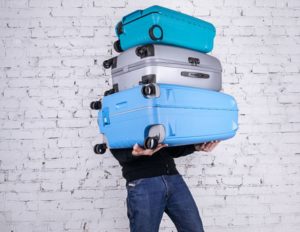Moving to a totally different environment from what you are used to opens up a wealth of opportunities for new experiences and growth. But if the actual moving cross-country part has got you a little anxious, there is some smart preparation that will help the transition go smoothly.
Here are 5 things you can do to prepare for a big move so that the experience is uplifting, with perhaps a bit less heavy lifting.
-
Consider Your Move Date
If you have flexibility in when you move, Moving.com suggests fall through spring. This avoids the peak season when movers are the busiest and most expensive. Mid-month and midweek also tend to be cheaper.
If you are moving coast to coast or beyond and plan to ship large items or vehicles, consider the cargo scheduling of the company you are working with and plan accordingly. For example, if you are truck shipping a car on October 15th, but the transport vehicle doesn’t leave til November 2nd, you will need to add the time your vehicle sits in the parking lot to the transit time, meaning it could be a few weeks before you see your car again. Similarly, you might want to time your arrival at your new destination close to the time when your furniture arrives.
If moving in summer is your only option, just plan early and make reservations well in advance for anything you will need to rent.
-
Have a Packing Plan
 With any move, it’s always good to hone down what you want to bring to your new home before you start packing. However, for a move across country, culling down your collection is even more critical. Review what you really want to bring, but also consider whether it will fit in where you are going. For example, north woods cabin furniture may not fit the light and breezy style of many coastal homes. Conversely a decoratively painted surfboard may not fit in Midwest America.
With any move, it’s always good to hone down what you want to bring to your new home before you start packing. However, for a move across country, culling down your collection is even more critical. Review what you really want to bring, but also consider whether it will fit in where you are going. For example, north woods cabin furniture may not fit the light and breezy style of many coastal homes. Conversely a decoratively painted surfboard may not fit in Midwest America.
Channel your inner Marie Kondo and take a look at everything you have in each category and ask yourself a few key questions about your affection for each item: Is it broken or worn out? Will I use this again? Is it a duplicate item? Did I even remember I had this? For each item you have, decide what pile it should go into:
- Keep
- Sell
- Donate
- Recycle
- Trash
By selling or donating unnecessary items, you may be able to:
- Lower potential moving costs
- Save time packing
- Pocket cash by selling items
- Cut down necessary storage space
- Reduce moving stress
Advise classy second hand shops of your items before the first garage sale and do a private pre-sale. Keep in mind that places like Salvation Army and Habitat for Humanity do not accept all items- check in advance. Give away for free hard to donate items like exercise equipment or a working hot-tub.
-
How to Move Your Stuff
Check different moving companies and the services they offer. Some are full service, including packing, transport and unpacking at your new location. Naturally, these will be the most expensive. However, some are a hybrid, allowing you to do most of your own packing. Or you can have a container dropped at your door, do all your own packing and have the moving company just handle the logistics of transportation.
Big Tip: Mark all boxes on the outside in bold black Sharpie with your name, the room items are going to and indication of content. Example: “Kitchen- Flatware and dishes.” If you have a moving company account number, put that on there too.
You may need to contact a specialized moving company if you are moving sensitive and valuable items like antiques, art, appliances, or pianos.
Get at least 3 quotes and make sure the movers are licensed and insured.
Tipping your movers is commonplace. Budget $10 per person for a half-day move and $20 for a full day on each end of the move.
-
The Minimalist Approach
 Having worked with clients doing cross country moves, we learned a few things. Some opt to move very few large items. If you’re stuck on keeping something “just in case,” you may want to try out The Minimalists’ 20/20 rule: if you can replace it for less than $20 in less than 20 minutes from your location, you should let it go. Keep only the things you need or that make you happy; it’s much better than filling up a closet with things that will never get unpacked.
Having worked with clients doing cross country moves, we learned a few things. Some opt to move very few large items. If you’re stuck on keeping something “just in case,” you may want to try out The Minimalists’ 20/20 rule: if you can replace it for less than $20 in less than 20 minutes from your location, you should let it go. Keep only the things you need or that make you happy; it’s much better than filling up a closet with things that will never get unpacked.
Here is how one client pared down a three-story house for a cross country move:
- Clothes, shoes and handbags- Most were brought over in suitcases on the airplane. A $25 extra bag fee is a cheap way to send 50lbs of clothes. With two free bags each plus carry-ons, they moved well over 300lbs of stuff for $50 plus tips for the airline curbside valet. They bought 3 serviceable suitcases at Goodwill for $30 just for the trip, then donated them back after the move. If you are purchasing a gently used item for one-time use, do an inspection to make sure it is clean with good operating wheels.
- Hand tools (drills, sander, favorite hand tools, etc)- Self-packed and shipped USPS priority with extra insurance. You can fit a lot into a square medium flat rate box! “If it fits it ships.”
- Electronics- Small items were hand carried, large items were professionally packed and shipped USPS priority with insurance by the local Mailboxes Etc store.
- Bathroom items/medicines- Self-packed and shipped USPS priority flat rate.
- Small kitchen tools- Self-packed and shipped USPS priority flat rate.
- Small meaningful décor items- Self-packed and shipped USPS priority with extra insurance. Get tips on packing breakables in this article by The Spruce.
- Artwork- Professionally packed and shipped USPS priority with insurance by Mailboxes Etc store
- Books- Double boxed and sent via USPS media mail. Note most people don’t pack books, but there are some people can’t live without a few favorite books!
- Bed- The couple purchased a memory foam mattress and new sheets online and had it shipped to their new address so they had an initial bed to sleep on. This bed later became a guest room bed.
- Cameras, jewelry, important papers and other small valuables- Packed in carry-ons.
- Vehicles- Whether to sell vehicles, ship or drive them to your new location depends on a variety of factors, including: The age of the vehicles- unless they are classic, vehicles over 5 years old may be due for a replacement; If vehicle is coming from a “rust belt” state, it may be better to sell and buy a vehicle from a less corrosive environment; Do the vehicles fit your new lifestyle- if you are going from farmland to mountains, you may want a 4WD vehicle; Cost of vehicles in your new destination- is it cheaper to buy vehicles where you are going to? Do a little research and see what works best for your move.
Big Tip- If you plan on mailing boxes through USPS, put in a change of address to your new home when leaving your old home. Then put a hold on your mail until you actually arrive at your new home. The post office will hold your mail and boxes then deliver them once you have arrived. You can do this all online at USPS.com
-
A Bit About Moving Insurance
Since you have packed only your most meaningful belongings, the last thing you want is to worry about them being damaged on their way to your destination. Moving insurance can give you peace of mind. By law, all moving companies must provide 2 coverage options for out-of-state moves: Full Value Protection and Released Value Protection. Full Value Protection requires movers to replace items damaged during moving or reimburse the current value. Released Value Protection only requires reimbursement at $0.60 per pound. You can ask the moving companies giving you quotes what expanded coverage they may offer, or, if your items are particularly valuable, you may want to consider carrying your own third-party moving insurance policy as well.
Ready to get moving?
 Start by making a to-do list of all the big tasks between now and moving day (you can fill in the details later). Having everything listed out on a timeline will allow you to manage the work in smaller chunks and not get overwhelmed.
Start by making a to-do list of all the big tasks between now and moving day (you can fill in the details later). Having everything listed out on a timeline will allow you to manage the work in smaller chunks and not get overwhelmed.
If you are moving within our local area, remember our Homes and Lakeshore team has a free moving truck for customers to use! Contact us at info@homesandlakeshore.com for details.
Opening boxes at the end of a move is a bit like opening a present. Plus, you likely will get to go shopping for some fun new items to match your new place.
